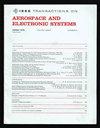基于动态调节器扩展和混合以及自适应分配的容错控制,适用于非对称损伤的固定翼飞机
IF 5.7
2区 计算机科学
Q1 ENGINEERING, AEROSPACE
IEEE Transactions on Aerospace and Electronic Systems
Pub Date : 2025-04-08
DOI:10.1109/TAES.2025.3558180
引用次数: 0
摘要
保持对非对称损坏飞机的有效控制对于保护机组人员的生命和减少财产损失至关重要。然而,由于飞机损伤导致的飞机参数的突然和实质性变化给控制带来了重大挑战。本文提出了一种容错控制结构。首先,对受损飞机模型进行重组,并将其表示为与致动器相关联的等效控制组件加上非线性函数的形式。然后,利用扩展状态观测器对非线性函数进行估计,推导出适合于参数辨识的形式。提出了一种基于改进动态回归扩展和混合的等效控制效率矩阵估计方法。通过引入第二个滤波器和平滑时变遗忘因子,使持续激励条件松弛,使其适用于飞机损坏情况下的参数估计。最后,提出了一种基于估计的等效控制效率矩阵的自适应控制分配算法,并使用辅助自适应变量有效地分配虚拟命令,即使在估计误差的情况下。为了验证该算法的有效性,我们研制了一架右翼损伤40%的固定翼飞机,并进行了风洞试验,获得了损伤前后的气动数据。随后进行了数值模拟和硬件在环实验。结果表明,该算法能够在参数未知的情况下快速稳定和控制受损飞机,验证了算法的有效性和实时性。本文章由计算机程序翻译,如有差异,请以英文原文为准。
Fault-Tolerant Control Based on Dynamic Regressor Extension and Mixing and Adaptive Allocation for Fixed-Wing Aircraft With Asymmetric Damage
Maintaining effective control of asymmetrically damaged aircraft is crucial for preserving the lives of the crew and mitigating property losses. However, the abrupt and substantial changes in aircraft parameters resulting from damage pose significant challenges to control. In this article, a fault-tolerant control structure is proposed. Initially, the damaged aircraft model is reorganized and expressed in the form of an equivalent control component associated with the actuator plus a nonlinear function. Subsequently, an extended state observer is used to estimate the nonlinear function and derive a form suitable for parameter identification. A method based on improved dynamic regressor extension and mixing is then introduced to estimate the efficiency matrix of equivalent control. By incorporating a second filter and a smooth time-varying forgetting factor, the persistent excitation condition is relaxed, rendering it suitable for parameter estimation in damaged aircraft scenarios. Finally, an adaptive control allocation algorithm is developed based on the estimated equivalent control efficiency matrix, with auxiliary adaptive variables used to effectively allocate virtual commands, even in cases of estimation error. To validate the efficacy of the proposed algorithm, we develop a fixed-wing aircraft with 40% damage to its right wing and conduct wind tunnel tests to obtain aerodynamic data before and after the damage occurs. Subsequently, numerical simulations and hardware-in-the-loop experiments are performed. The results demonstrate that the proposed algorithm is capable of rapidly stabilizing and controlling the damaged aircraft, even when parameters are unknown, thus confirming its effectiveness and real-time performance.
求助全文
通过发布文献求助,成功后即可免费获取论文全文。
去求助
来源期刊
CiteScore
7.80
自引率
13.60%
发文量
433
审稿时长
8.7 months
期刊介绍:
IEEE Transactions on Aerospace and Electronic Systems focuses on the organization, design, development, integration, and operation of complex systems for space, air, ocean, or ground environment. These systems include, but are not limited to, navigation, avionics, spacecraft, aerospace power, radar, sonar, telemetry, defense, transportation, automated testing, and command and control.

 求助内容:
求助内容: 应助结果提醒方式:
应助结果提醒方式:


